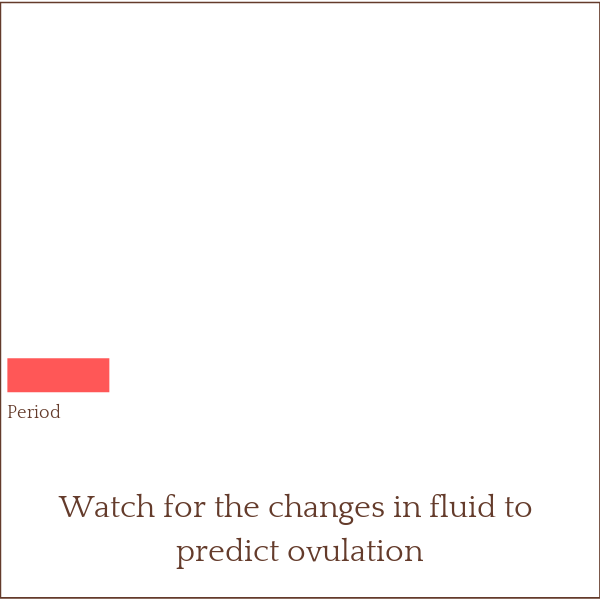How do you know when you're ovulating?
Why your period dates aren’t enough to predict ovulation
If you are anything like me you’ve been tracking your period for a long time.
But there’s a big problem. Your period is only one part of your cycle!
And the important baby making part, ovulation, cannot be reliably predicted using your period.
Your body can change ovulation date based on the health and maturity of your eggs, other hormone levels, and even perceived stress!
So maybe your period tracking app says you should be ovulating on day 16, but in reality, your brain is monitoring all of these elements inside your body and if it doesn’t think the eggs are ready or the condition is just right, you might not ovulate until day 18.
This is why tracking your period is not enough if you want to get pregnant naturally.
You need an easy, reliable, consistent way to predict ovulation.
You need to know how to recognize your fertile signs.
We’re going to cover the three most powerful fertile signs to predict exactly when you will ovulate. I’m sure you’ve heard of at least one of these. When used together, you can very accurately predict ovulation and even get confirmation that your prediction was correct.
Cervical Fluid
In the days leading up to ovulation your cervical fluid will change to become super sperm friendly.
It becomes this amazing fluid that can help sperm travel farther, travel faster, and stay alive during the journey.
You may not have a lot of cervical fluid to observe yet. But it’s important to know all of the fertile signs, so that as you’re making changes and improving your health, you’ll recognize these signs as soon as they do show up.
The typical cervical fluid pattern looks like this:
Your cycle starts with your period.
It’ll be dry right after
Then start to become watery
It can be creamy, almost lotion looking
And the most fertile fluid is stretchy and clear, like raw egg white. This is the magical baby making stuff. You don’t need a lot. A thread that is clear and stretchy is all you need to indicate ovulation is just around the corner.
After ovulation, your cervical fluid will be dry again until your next period.
The ramping up pattern is what indicates that estrogen is increasing and you’re getting ready to ovulate.
Ovulation Test Strips & Ovulation Predictor Kits
As you see your cervical fluid becoming more fertile, begin using ovulation test strips.
These check for luteinizing hormone which is the catalyst for ovulation.
I like to have people test twice a day and you will see the positive line go from light, to medium, to dark, to really dark.
You will ovulate within 12-48 hours after the LH surge. So cervical fluid tells you it’s coming, ovulation strips tell you it’s happening.
Important note: women with PCOS often have higher than normal levels of luteinizing hormone. So if you’re getting a positive each time you test, that’s just a sign that there’s a little more work to do to normalize your cycle.
Basal Body Temperature
I also recommend tracking basal body temperature because it confirms ovulation.
After you ovulate the follicle becomes a corpus luteum which produces progesterone. Progesterone increases your body temperature. If you imagine incubating an egg, it needs to be warm.
So you will be able to see a clear and sustained increase in temperature once the corpus luteum is working.
The blue line shows your temperature each morning. You can see during your period and the first half of the cycle, the temperatures are all different each day, that doesn’t really matter, they’re all within a lower temperature range. After ovulation, you get a spike in temperature and then they stay in this upper range.
This increase happens because the follicle successfully release an egg and is now producing progesterone.
Conclusion: A Powerful Combination to Predict Ovulation
By using all three of these fertile signs you’ll know when ovulation is about to happen, when it’s happening, and confirmation that it definitely happened.
You might be wondering why you really need confirmation from your temperature changes.
When you have PCOS your body may try to ovulate multiple times before it’s successful. You could see fertility signs increase, get a positive ovulation strip, a one day rise in temperature, and then it all falls down again and your body goes through the same cycle a few days later. If you aren’t tracking temperatures you would have thought ovulation occurred and you stop trying for the month. By tracking your temperatures you’ll never miss an opportunity.
There’s one more benefit to knowing how to recognize your fertile signs. You get to see your improvements month after month. Change takes time. Your PCOS didn’t develop overnight and it’s going to take some focused effort overcome it and become pregnant naturally. As the changes you’re making start to take effect, you’ll see improvements in your charts too.
Putting it into action
If this topic is interesting to you and you’d like to learn how to start tracking these signs and geek out with me over the data you collect in your charts, then I invite you to join the Everyday Fertility class that I’m teaching online starting April 3, 2019! Click the picture below to learn more and register for the live class!





